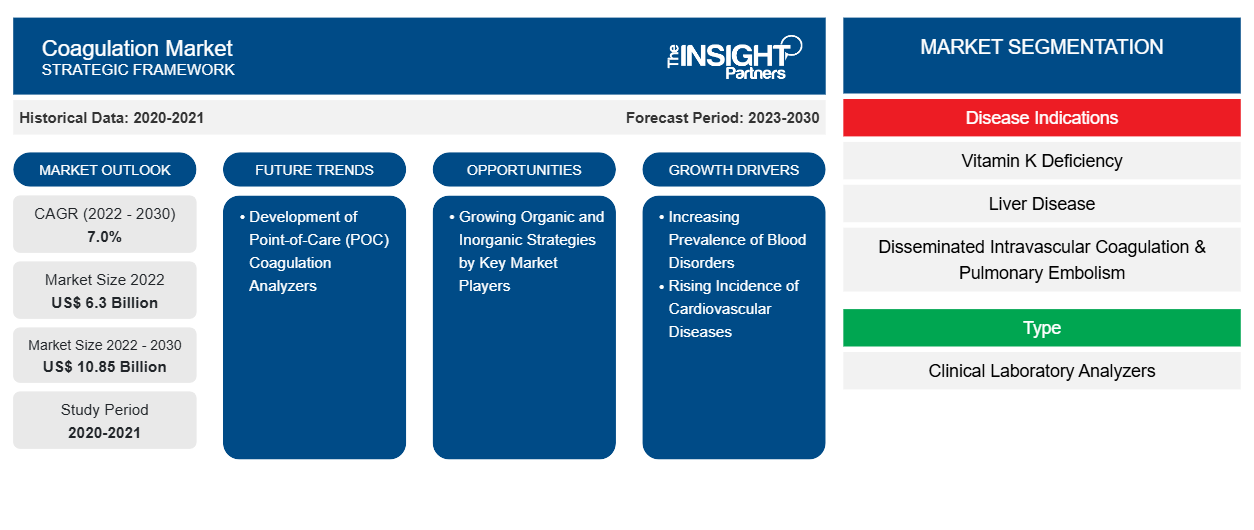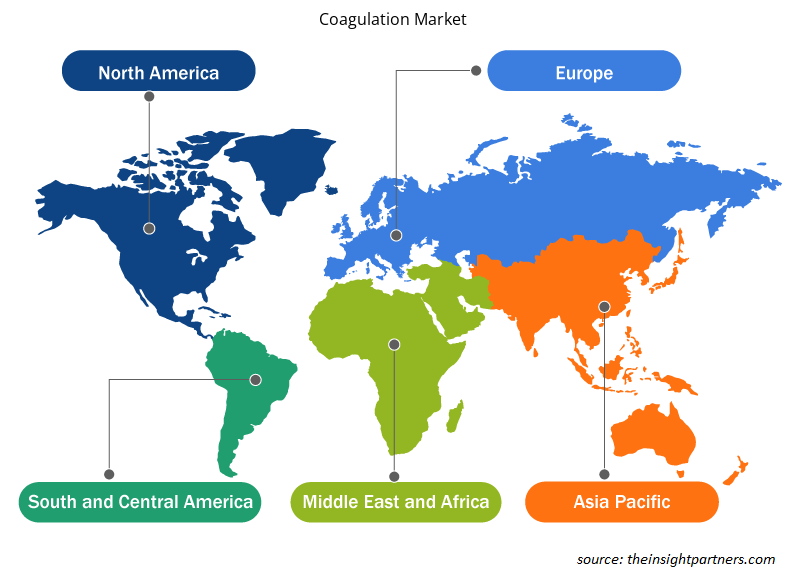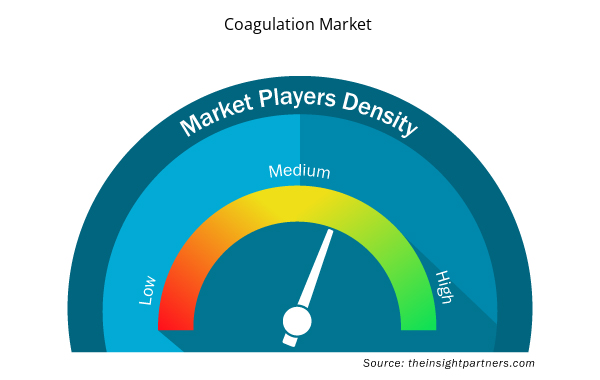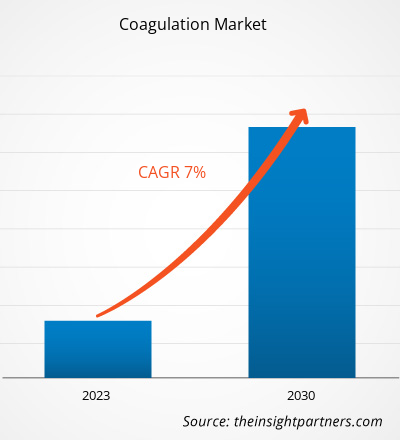[Research Report] The coagulation market is expected to grow from US$ 6,295.28 million in 2022 to US$ 10,853.28 million by 2030; it is anticipated to record a CAGR of 7.0% from 2022 to 2030.
Market Insights and Analyst View:
The coagulation market size is expanding with the increasing cases of blood clotting and other blood-related disorders that lead to blood clots. The Medsafe New Zealand Medicines and Medical Device Safety Authority estimates that 2–6 per 10,000 women taking oral contraceptives face blood clotting conditions annually. Anticoagulant medications, also known as blood thinners, are primarily used in the prevention and treatment of blood clots. Taking blood thinners while in the hospital is common, especially in the first 5–10 days after diagnosis, when the condition is thought to be the most severe or acute. However, those with suitable risk profiles may initially be prescribed blood thinners for use at home. Also, an increase in the cases of cardiovascular diseases, which may be caused due to blood clotting in heart arteries, is fueling the growth of the coagulation market.
Growth Drivers and Challenges:
Hemophilia A is one of the common X-linked recessive disorders and the second most common inherited clotting factor deficiency after von Willebrand disease, according to the National Organization of Rare Disorders. Also, ~1 in 5,000 male infants suffers from hemophilia A in the US. According to the Global Hemophilia Care 2020 study, 393,658 bleeding disorder cases have been detected and documented worldwide over time—including 241,535 hemophilia cases, 87,729 von Willebrand disease cases, and 64,394 other bleeding disorder cases. According to the National Library of Medicine (NLM), ~30,000–33,000 men were affected by hemophilia in the US in 2020.
As per the reports from the American Cancer Society (CLL), the US recorded ~21,250 new cases of chronic lymphocytic leukemia in 2021. A February 2020 update from the Centers for Disease Control and Prevention (CDC) states that the number of people in the US affected by deep vein thrombosis could reach 900,000 (1–2 per 1,000). The same source estimates that in the US 60,000–100,000 Americans die yearly from venous thromboembolism. According to the US Department of Health & Human Services, ~100,000 Americans were diagnosed with sickle cell disease (SCD) in 2020, which is one of the most commonly inherited blood disorders. In addition, the number of people suffering from SCD is expected to grow by ~30% by 2050.
According to the National Library of Medicine, in 2020, 80 million people were suffering from blood disorders in the European Union. The National Organization for Rare Disorders stated that immune thrombocytopenia (ITP), an autoimmune bleeding disorder, affected ~66 adults per 1 million in the US each year in 2022. Therefore, the rising prevalence of blood disorders drives the coagulation market growth.
Point-of-care (POC) coagulation analyzers offer significant advantages compared to traditional coagulation analyzers. However, the costs of POC analyzers are higher than affordable laboratory tests. As per the Canadian Agency for Drugs and Technologies in Health (CADTH), the average cost of Roche's CoaguChek ranged from US$ 500 to US$ 2,000, compared to the cost of the PT-INR assay test ranging from US$ 4 to US$ 31. The costs can be combined with the additional costs of battery and maintenance, resulting in higher total annual costs for POC coagulation analyzers. Therefore, the high cost of these testing analyzers limits their adoption and growth in emerging markets.
Deploying coagulation analyzers into clinical settings and offering them to patients leads to a significant financial impact on services offered by healthcare providers. Siemens Healthineers offers a floor-standing coagulation analyzer that costs US$ 250,000. The annual service maintenance cost of a coagulation analyzer ranges from ~US$ 2,000 to US$ 3,000. Further, companies manufacturing coagulation analyzers need to comply with a few stringent rules and regulations set by government organizations to gain approval for their commercial launch, which further adds to the overall price of these devices. Thus, the high costs associated with coagulation analyzers restrain the coagulation market growth.
Customize This Report To Suit Your Requirement
You will get customization on any report - free of charge - including parts of this report, or country-level analysis, Excel Data pack, as well as avail great offers and discounts for start-ups & universities
Coagulation Market: Strategic Insights

- Get Top Key Market Trends of this report.This FREE sample will include data analysis, ranging from market trends to estimates and forecasts.
Customize This Report To Suit Your Requirement
You will get customization on any report - free of charge - including parts of this report, or country-level analysis, Excel Data pack, as well as avail great offers and discounts for start-ups & universities
Coagulation Market: Strategic Insights

- Get Top Key Market Trends of this report.This FREE sample will include data analysis, ranging from market trends to estimates and forecasts.
Report Segmentation and Scope:
The coagulation market is divided on the basis of disease indication, type, offering, technology, end user, and geography. Based on disease indications, the coagulation market is segmented into vitamin K deficiency, liver disease, disseminated intravascular coagulation & pulmonary embolism, development of circulating anticoagulants, hemophilia, von Willebrand’s disease, and others. Based on type, the coagulation market is bifurcated into clinical laboratory analyzers and point-of-care testing analyzers. Clinical laboratory analyzers are further categorized as controls and calibrators, assays and reagents, instruments/systems, coagulation factors, and others. Based on offering, the coagulation market is bifurcated into diagnosis and treatment. The diagnosis segment is further classified into prothrombin time testing, fibrinogen testing, activated clotting time testing, activated partial thromboplastin time testing, D-dimmer testing, platelets function testing, and others. The treatment segment is further classified into anti-fibrinolytic drugs, birth control pills, desmopressin and immunosuppressive medicines, vitamin K supplements, blood thinners, thrombin inhibitors or thrombolytics, replacement therapies, catheter-assisted thrombus removal, and others. Based on technology, the coagulation market is segmented into optical technology, mechanical technology, electrochemical technology, and others. The coagulation market, by end user, is segregated into clinical laboratories, hospitals, and others. Based on geography, the coagulation market is segmented into North America (the US, Canada, and Mexico), Europe (the UK, Germany, France, Italy, Spain, and the Rest of Europe), Asia Pacific (China, Japan, India, South Korea, Australia, and the Rest of Asia Pacific), the Middle East & Africa (the UAE, Saudi Arabia, South Africa, and Rest of the Middle East & Africa), and South & Central America (Brazil, Argentina, and the Rest of South & Central America).
Segmental Analysis:
Based on offering, the coagulation market is bifurcated into diagnosis and treatment. The diagnosis segment is further classified into prothrombin time testing, fibrinogen testing, activated clotting time testing, activated partial thromboplastin time testing, D-dimmer testing, platelets function testing, and others. The treatment segment is further classified into anti-fibrinolytic drugs, birth control pills, desmopressin and immunosuppressive medicines, vitamin K supplements, blood thinners, thrombin inhibitors or thrombolytics, replacement therapies, catheter-assisted thrombus removal, and others. In 2022, the diagnosis segment held a larger share of the coagulation market. The treatment segment is anticipated to register a higher CAGR during 2022–2030. Coagulation plays an important role in the diagnosis of clotting disorders and in monitoring patients who take drugs that impact the clotting process. Fibrinogen testing assesses the levels of fibrinogen protein, a clotting factor. When the body's tissues or blood vessels are damaged, clotting factors combine to form blood clots and stop bleeding. Fibrinogen tests are used to keep track of individuals who exhibit symptoms such as excessive bleeding or unusual blockages in veins or arteries.
The activated clotting time (ACT) test is primarily used to keep track of high doses of unfractionated heparin therapy. ACT is commonly used to monitor high-dose heparin treatment before, during, and for a short time after medical or surgical procedures that require blood clotting prevention, such as heart bypass surgery, coronary angioplasty, and dialysis. It is a quick test that can be conducted at patient's bedside before surgery or other medical procedures. It can also be performed in or near operating rooms at regular intervals during and immediately following surgeries.
Platelets’ ability to aggregate and promote clotting is measured by a variety of assays known as platelet function tests using specialized equipment. Platelet function tests may be used for other purposes besides assessing people for excessive bleeding. These tests are performed to reduce platelets' aggregation ability, especially in people who are more likely to experience heart attacks or harmful blood clots. These patients might be given drugs that lessen platelet activation or their aggregation capacity. Platelet function tests may be performed on patients taking these anti-platelet drugs, such as low-dose aspirin or clopidogrel, to track the effectiveness of their treatment.
A thrombus can be ruled out using the D-dimmer test. The D-dimmer test is used in the diagnosis of deep vein thrombosis (DVT), stroke, and pulmonary embolism (PE). The D-dimer test is recommended as an additional test. As D-dimer is a sensitive but poor specificity test, it should only be used to rule out DVT and not to confirm a diagnosis.
Regional Analysis:
Based on geography, the coagulation market is divided into North America, Europe, Asia Pacific, Middle East & Africa, and South & Central America. North America is the largest contributor to the growth of the coagulation market. Asia Pacific is expected to register the highest CAGR in the coagulation market during 2022–2030. North America accounts for a significant coagulation market share owing to the growing incidences of blood disorders, increasing occurrence of cardiovascular diseases such as atrial fibrillation (AFib), and the presence of major market players engaged in new and existing product developments. Moreover, government support for preventing blood disorders is anticipated to boost the North America coagulation market growth during the forecast period. The US holds the largest share of the coagulation market in North America. According to the Centers for Disease Control and Prevention (CDC), AFib was mentioned as a cause of death on ~183,321 death certificates in the US in 2019, and it was the primary cause of death in nearly 26,535 of these cases. Moreover, 12.1 million people in the US are anticipated to suffer from AFib by 2030. CDC data also mentions that hemophilia A affects 1 in 5,000 male births in the US; moreover, ~400 babies are born with Hemophilia A each year. It also mentioned that ~33,000 males in the US were diagnosed with hemophilia during 2012–2018. Further, nearly 3 million people in the country suffer from anemia. Millions of people in the US carry genes that can cause blood disorders such as sickle cell anemia and hemophilia. According to the US Department of Health and Human Services, sickle cell disease (a blood disorder) affects more than 100,000 people in the country. The source also mentions that Von Willebrand disease (VWD) is among the most common inherited blood disorders in women in the US. Thus, the increasing incidences of cardiovascular diseases and blood disorders are likely to bolster the coagulation market growth in the US.
Industry Developments and Future Opportunities:
Various initiatives by key players operating in the Coagulation Market are listed below:
- In August 2021, Siemens Healthineers Launched Sysmex CN-3000 and CN-6000 Hemostasis Systems. These fully automated systems enable diagnostics personnel to effectively perform both mid- and high-volume coagulation tests in laboratories.
- In July 2020, Sysmex Launched CN-6500 and CN-3500 automated blood coagulation analyzers in Japan and EMEA. These integrated analyzers incorporate features of their predecessors the CN-6000/CN-3000, such as high levels of productivity, reliability, operability, and serviceability. They consist of a measuring unit using chemiluminescence enzyme immunoassay methodology (CLEIA), a measuring principle developed with Automated Immunoassay Systems. The CN-6500 and CN-3500 analyzers allow for flexible measurements in response to a broad range of test orders in the fields of thrombosis and hemostasis, including molecular markers for blood coagulation with a single device..
Coagulation Market Regional Insights
Coagulation Market Regional Insights
The regional trends and factors influencing the Coagulation Market throughout the forecast period have been thoroughly explained by the analysts at Insight Partners. This section also discusses Coagulation Market segments and geography across North America, Europe, Asia Pacific, Middle East and Africa, and South and Central America.

- Get the Regional Specific Data for Coagulation Market
Coagulation Market Report Scope
| Report Attribute | Details |
|---|---|
| Market size in 2022 | US$ 6.3 Billion |
| Market Size by 2030 | US$ 10.85 Billion |
| Global CAGR (2022 - 2030) | 7.0% |
| Historical Data | 2020-2021 |
| Forecast period | 2023-2030 |
| Segments Covered |
By Disease Indications
|
| Regions and Countries Covered | North America
|
| Market leaders and key company profiles |
Coagulation Market Players Density: Understanding Its Impact on Business Dynamics
The Coagulation Market market is growing rapidly, driven by increasing end-user demand due to factors such as evolving consumer preferences, technological advancements, and greater awareness of the product's benefits. As demand rises, businesses are expanding their offerings, innovating to meet consumer needs, and capitalizing on emerging trends, which further fuels market growth.
Market players density refers to the distribution of firms or companies operating within a particular market or industry. It indicates how many competitors (market players) are present in a given market space relative to its size or total market value.
Major Companies operating in the Coagulation Market are:
- NORDIC BIOMARKER
- ImproGen Diagnostik Kimya San. & Tic. Ltd.
- Diagnostica Stago, Inc.
- Siemens Healthcare Private Limited
- Sysmex
Disclaimer: The companies listed above are not ranked in any particular order.

- Get the Coagulation Market top key players overview
Competitive Landscape and Key Companies:
A few of the prominent players operating in the coagulation market are NORDIC BIOMARKER; ImproGen Diagnostik Kimya San. & Tic. Ltd.; Diagnostica Stago, Inc.; Siemens Healthcare Private Limited, Sysmex; Helena Biosciences; F. Hoffmann-La Roche Ltd; Genrui Biotech Co., Ltd.; Transasia Bio-Medicals; and HORIBA Medical. These companies focus on new product launches and geographic expansions to meet the growing consumer demand worldwide and increase their product range in specialty portfolios. Their global presence allows them to serve a large base of customers, subsequently facilitating market expansion.
- Historical Analysis (2 Years), Base Year, Forecast (7 Years) with CAGR
- PEST and SWOT Analysis
- Market Size Value / Volume - Global, Regional, Country
- Industry and Competitive Landscape
- Excel Dataset



Report Coverage
Revenue forecast, Company Analysis, Industry landscape, Growth factors, and Trends

Segment Covered
Disease Indications, Type, Offering, Technology, End User, and Geography

Regional Scope
North America, Europe, Asia Pacific, Middle East & Africa, South & Central America

Country Scope
This text is related
to country scope.
Frequently Asked Questions
The coagulation market majorly consists of the players such NORDIC BIOMARKER; ImproGen Diagnostik Kimya San. & Tic. Ltd.; Diagnostica Stago, Inc.; Siemens Healthcare Private Limited; Sysmex; Helena Biosciences; F. Hoffmann-La Roche Ltd; Genrui Biotech Co., Ltd.; Transasia Bio-Medicals; HORIBA Medical among others.
The factors such as the growing prevalence of blood disorders and rising incidence of cardiovascular diseases are the key driving factors behind the market development. However, the high costs associated with coagulation analyzers is hampering the market growth.
Coagulation or clotting is the process by which blood turns from a liquid into a gel and forms a blood clot. This potentially leads to hemostasis, which is the interruption of blood loss from a damaged vessel, followed by repair. Coagulation analyzer measures and evaluates the rate of clot formation or clot coagulation. It helps prevent the risk of heart attacks, embolism, and thrombosis by identifying the blood clots in the blood vessels. Obesity, heart attack, diabetes, and high blood pressure are diseases caused by lifestyle changes. Therefore, this device is a primary diagnostic tool for conditions like these. The demand for such devices in hospitals is increasing since it is a powerful automated device that serves as diagnostic tool for blood-related diseases.
The coagulation market is analyzed on the basis of disease indication, type, offering, technology, and end user. Based on disease indications, the coagulation market is segmented into vitamin K deficiency, liver disease, disseminated intravascular coagulation & pulmonary embolism, development of circulating anticoagulants, hemophilia, von Willebrand disease, and others. The liver disease segment held the largest share of the coagulation market in 2022. Further, the hemophilia segment is anticipated to register the highest CAGR from 2022 to 2030.
Trends and growth analysis reports related to Life Sciences : READ MORE..
The List of Companies - Coagulation Market
- NORDIC BIOMARKER
- ImproGen Diagnostik Kimya San. & Tic. Ltd.
- Diagnostica Stago, Inc.
- Siemens Healthcare Private Limited
- Sysmex
- Helena Biosciences
- F. Hoffmann-La Roche Ltd
- Genrui Biotech Co., Ltd.
- Transasia Bio-Medicals
- HORIBA Medical

 Get Free Sample For
Get Free Sample For